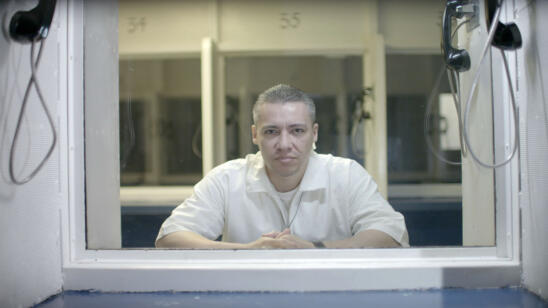Warning: The following contains disturbing descriptions of violence. Reader discretion is advised.
It was a hot summer Friday in Texas when 30-year-old Betty Gore was violently killed in her home with an axe. Candace “Candy” Montgomery, a 30-year-old family friend, fellow church member and ex-lover of Gore’s husband, was soon arrested for the crime.
During her trial, Montgomery admitted to hitting Gore multiple times with the axe, leaving the crime scene and covering up evidence.
Montgomery also claimed she’d acted in self-defense. She was found not guilty.
Betty Gore’s Body Is Found
On June 13, 1980, Betty Gore’s husband Allan traveled to Minnesota on business. That evening, he became worried when he couldn’t reach his wife at their home in Wylie, Texas.
[Stream episodes of American Justice in the A&E App.]
Allan called neighbors for help. A few went to the house, where they discovered Betty Gore in a bloody utility room. A three-foot axe was found nearby.
Also in the house was the Gores’ nearly 1-year-old daughter, who had been left unattended for hours.
Gore had been attacked so forcefully that it seemed the right half of her face was missing. The investigation revealed she’d received 41 axe blows.
Police at first thought a vicious killer was on the loose. Then Allan confessed to police he’d had an affair with Candace “Candy” Montgomery, a housewife and friend of the Gore family. The affair began in December 1978 and lasted until October 1979. Montgomery was the last person to see Gore alive on the morning of June 13, when she’d gone to pick up a swimsuit for the Gores’ older daughter, who was friends with the Montgomery children and had slept at their house. And her fingerprints matched a bloody print found at the scene.
Two weeks after Gore’s murder, Montgomery, the main suspect, was arrested.
Candy Montgomery Goes on Trial
Montgomery’s lawyer, who’d previously insisted his client was innocent, shocked everyone in court on October 20, 1980, when he told prospective jurors that his client had killed Gore in self-defense.
On October 23, Montgomery took the stand and gave her account of what happened at the Gore house on June 13. She said Gore had asked her about the affair with Allan. Montgomery said the relationship had taken place, but was now over.
Gore brought out an axe and ordered Montgomery to stay away from her husband. Gore then put the axe down to gather things for Montgomery to take to her daughter.
When about to leave the house, Montgomery placed her hand on Gore’s arm and expressed sympathy. Gore then pushed Montgomery into the utility room, where she swiped Montgomery’s head and cut her toe with the axe.
Montgomery got control of the weapon and managed to hit the back of Gore’s head. However, she said Gore still prevented her from leaving. The women again fought for the axe, with Montgomery pleading for Gore to let her go and telling Gore she didn’t want her husband.
Then Gore said, “Shhh.” At this, Montgomery seized the axe and struck Gore.
“I didn’t think,” Montgomery testified at her murder trial. “I raised it and I hit her, and I hit her, and I hit her and I hit her.”
The medical examiner, Dr. Vincent DiMaio, determined that Gore’s heart was beating for 40 of the 41 blows, though he later testified she was likely unconscious for most of the attack.
On the stand, Montgomery also admitted to taking a shower at the Gore house before leaving, with the baby still upstairs. She went home to change her clothes, returned to the church where her children and the older Gore daughter were attending Bible school, then lunched with friends.
Montgomery also later destroyed and threw out the scraps of the sandals she’d been wearing when she killed Gore.
Yet these actions did not alter her self-defense argument, nor did it change the burden of proof.
“Whether she leaves the baby, tries to clean up the crime scene, removes evidence, those are separate criminal offenses,” Brian Hobson, a partner at Odom, Davis & Hobson, tells A&E True Crime. “The state has to prove that it wasn’t self-defense beyond a reasonable doubt.”
On October 27, Dr. Fred Fason, a psychiatrist who’d examined Montgomery on behalf of the defense took the stand.
Fason, who had placed Montgomery under hypnosis months prior, explained that when Gore had said, “Shhh,” Montgomery associated it with a childhood incident. A 4-year-old Montgomery, angered by losing a race, broke a glass jar and cut her head. At the hospital, her mother shushed her.
According to Fason, Gore saying, “Shhh,” to Montgomery unleashed years of pent-up rage.
Hobson says of the psychiatric testimony, “To me, that’s the most interesting part of the case legally, because that’s not the type of evidence you would normally see in self-defense.”
“My hunch is that the defense really needed to address the 41 strikes,” he adds. “A jury’s going to have a real hard time wrapping their brain around self-defense with those facts unless you have some sort of explanation.”
The Verdict and Aftermath
Final arguments in the trial were heard on October 29, 1980. That same day, Montgomery was found not guilty of both murder and manslaughter.
The verdict was met with shock from the community. Many didn’t buy the self-defense argument. Cries of “Murderer!” greeted Montgomery as she left the courthouse.
A juror later told The Dallas Morning News of the 41 axe blows, “We determined it never had a bearing on the verdict at all—whether it was one gunshot or 1,000 whacks.”
Following her acquittal, Montgomery left Texas, moved to Georgia and became a family counselor.
Though it doesn’t change the verdict, forensic psychologist John Delatorre questions the psychiatric explanation offered at Montgomery’s trial. “The childhood memory would not spur her to erupt in violence,” he tells A&E True Crime.
Delatorre adds, “She certainly could have linked her mother’s statements and actions at that point as being indicative of a dismissive-type person, but then when anyone said ‘shhh’ throughout her life, she would have had a negative reaction, which does not appear to be the case.”
Whatever caused Montgomery’s actions, it was Gore who paid the ultimate price. And her family had to live with the aftermath of her death.
“As far as I’m concerned, justice will be served. [Montgomery] has to live with it,” Bob Pomeroy, Gore’s father, told United Press International. “I wouldn’t say I was happy with the verdict. We don’t know what happened, and we never will know what happened.”
Related Features
Over a Century Ago, a Mysterious Axe Murderer Rode the Rails, Chopping Up Families Along the Way
The Staircase Murder of Kathleen Peterson: What Really Caused Her Death?
Acting in Self-Defense: What It Means in the Eyes of the Law


